
The horned grebe or Slavonian grebe is a relatively small waterbird in the family Podicipedidae. There are two known subspecies: P. a. auritus, which breeds in the Palearctic, and P. a. cornutus, which breeds in North America. The Eurasian subspecies is distributed over most of northern Europe and the Palearctic, breeding from Greenland to western China. The North American subspecies spans most of Canada and some of the United States. The species got its name from large patches of yellowish feathers located behind the eyes, called "horns", that the birds can raise and lower at will.

The white-tailed jackrabbit, also known as the prairie hare and the white jack, is a species of hare found in western North America. Like all hares and rabbits, it is a member of the family Leporidae of order Lagomorpha. It is a solitary individual except where several males court a female in the breeding season. Litters of four to five young are born in a form, a shallow depression in the ground, hidden among vegetation. This jackrabbit has two described subspecies: L. townsendii townsendii occurring west of the Rocky Mountains and L. townsendii campanius occurring east of the Rocky Mountains.

The Gomphidae are a family of dragonflies commonly referred to as clubtails or club-tailed dragonflies. The family contains about 90 genera and 900 species found across North and South America, Europe, Asia, and Australia. The name refers to the club-like widening of the end of the abdomen. However, this club is usually less pronounced in females and is entirely absent in some species.

The horned parakeet is a species of parrot in the genus Eunymphicus, in the family Psittaculidae. It is a medium-sized parrot endemic to New Caledonia. It is called "horned" because it has two black feathers that protrude from the head and have red tips.
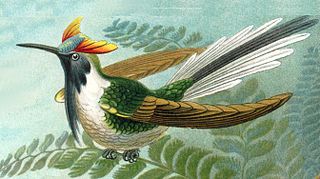
The horned sungem is a species of hummingbird in the subfamily Polytminae, the mangoes. It occurs in Bolivia, Brazil, and Suriname.
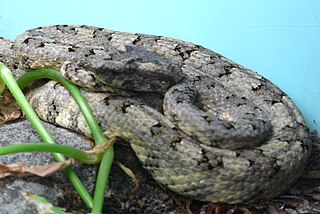
Protobothrops cornutus, commonly known as the horned pit viper or Fan-Si-Pan horned pitviper, is a venomous pit viper species found in northern and central Vietnam and in southern China (Guangdong). No subspecies are currently recognized.
The common shiner is a freshwater fish of the family Cyprinidae, found in North America. It ranges in length between 4 and 6 inches, although they can reach lengths of up to 8 inches.

Arigomphus is a genus of dragonflies of the Gomphidae family. This group is commonly called the pond clubtails. The species are fairly plain and only the males have the club-shaped abdomen. Unlike other gomphids, they may emerge from artificial ponds.

Gomphurus externus, the plains clubtail, is a species of dragonfly in the family Gomphidae.
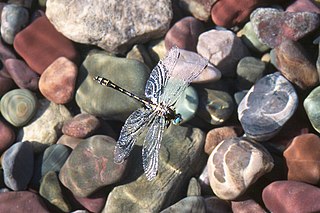
Phanogomphus graslinellus is a species of dragonfly in the family Gomphidae. This species is commonly known as the pronghorn clubtail.

Phanogomphus quadricolor, the rapids clubtail, is a species of dragonfly in the family Gomphidae. It is found in eastern North America. Its natural habitat is medium to large rivers. It is threatened by degrading habitat quality.
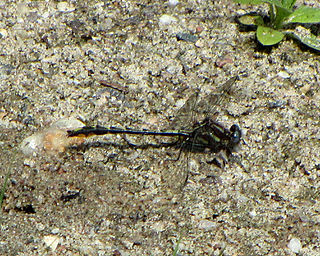
Phanogomphus exilis, the lancet clubtail, is a species of dragonfly in the family Gomphidae widespread and common throughout southern Manitoba, Ontario, and the northeastern United States.

Ictinogomphus rapax, the Indian Common Clubtail, is a species of dragonfly in the family Gomphidae. It is found throughout the Orient region.
Citharichthys amblybregmatus is a species of flatfish in the large-tooth flounder family Paralichthyidae. It is native to the western north Atlantic Ocean. It has been collected at a depth of 198 m (650 ft).

The white-legged duiker is a medium-sized antelope species from the subfamily of duikers (Cephalophinae) within the family of bovids (Bovidae). It is native to Gabon and the Republic of the Congo. It was described as subspecies of the Ogilby's duiker by Peter Grubb in 1978. After a revision of the ungulates in 2011 by Colin Groves, it is now regarded as distinct species.

Citharichthys cornutus, the horned whiff, is a species of flatfish in the large-tooth flounder family Paralichthyidae. This bathydemersal marine fish inhabits the continental shelves of the western Atlantic Ocean, in both tropical and subtropical waters. It ranges from New Jersey in the north to Uruguay in the south, though larvae samples have also been collected off the coast of Canada. It occurs at depths between 30 and 400 metres, though it is usually found in deeper waters.
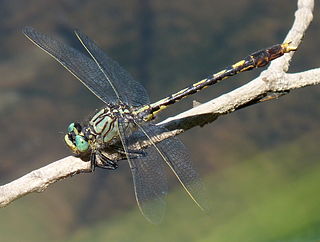
Arigomphus villosipes, the unicorn clubtail, is a species of clubtail in the dragonfly family Gomphidae. It is found in North America.
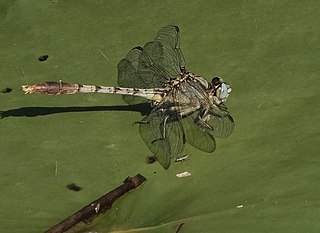
Arigomphus lentulus, the stillwater clubtail, is a species of clubtail in the family of dragonflies known as Gomphidae. It is found in North America. This dragonfly species can breed in calm waters. Like many dragonflies, this species feeds on small flying insects.

Arigomphus furcifer, the lilypad clubtail, is a species of clubtail in the family of dragonflies known as Gomphidae. It is found in North America.



















